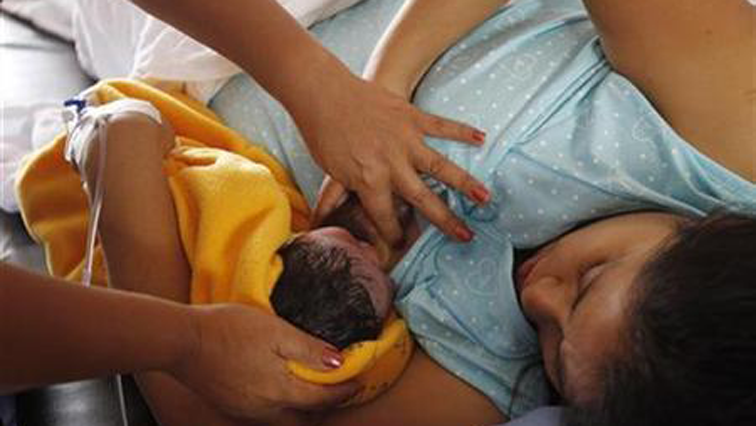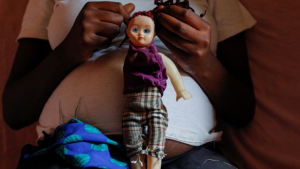South Africa’s National Development Plan 2030 was adopted in 2012. As part of the same plan, the National Integrated Early Childhood Development (ECD) Policy was adopted in 2015.
Following the adoption of the policy, Knowledge Information and Data Solutions (KiDS) compiled a comprehensive report on the country’s progress in ECD. Together with various stakeholders including the Department of Planning, Monitoring and Evaluation (DPME) in the Presidency, the report was compiled in 2019 using data from 2017.
Population and area type
2017 data reveals that South Africa had a population of just under 7 million children under the age of 6 years. The provinces of Gauteng and KwaZulu-Natal have close to 3 million of that population of children.
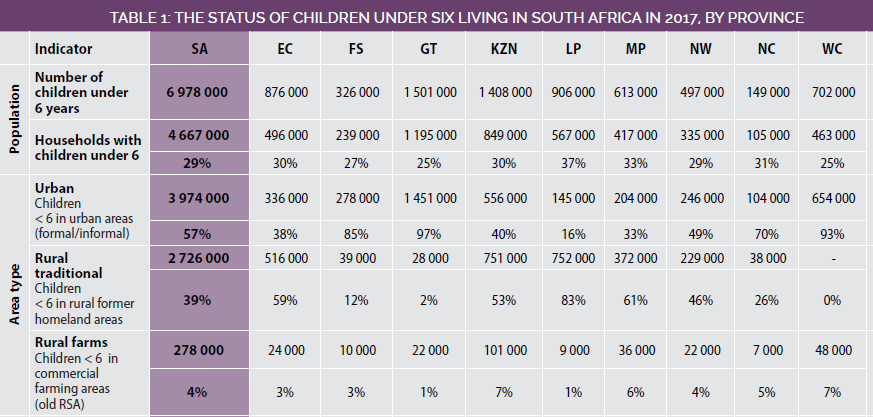
57% of the children live in urban areas that constitute both formal and informal settlements. Again KwaZulu-Natal and Gauteng have the most children living in urban areas.
Access to services and poverty levels
29% or just over 2 million children under the age of 6 do not have access to piped water. The stats also reveal that over 1.5 million children do not have access to a toilet, be it permanent or a portable facility.
Poverty affects a large percentage of children under the age of 6 years. 65% or over 4.5 million of these children live in households that have an income of R1138 or less per month. The data further reveals that more than 2.5 million do not have sufficient access to food, with them living in households that have an income of less than R531 per month.
KwaZulu-Natal, the Eastern Cape and Limpopo are three provinces that are most affected by children living in poverty or do not have sufficient access to food.
With South Africa’s total unemployment tethering around the 30% mark, children under the age of 6 years are heavily affected by the scourge with many living in households with no adult employed. Over 2 million children under the age of six lived in a household with neither a caregiver nor parent employed.
Maternal and child health
The report reveals that as much as South Africa’s health system has faced many challenges, the gains achieved post-apartheid in households of poor mothers and children have been realised through the health sector.
The health sector has played a pivotal role not only in care for mothers and new borns, it has also linked up with other departments in terms of registering births, child support grants and parental education and nutritional education for young children.
South Africa maintains a high percentage of facility-based births. In 2016, 96% of all child births happened at a health facility. 85% of those births happened at public health facilities.
The country has also made great strides in immunisation of children. Immunization is an important foundation for the health of children going forward.
The South African Childhood Review report reveals, “Immunisation coverage had increased from less than 70% in 2000 to almost 90% in 2015.”
However, when Stats SA recalibrated the mid-year population estimates in 2017, the under-1 immunisation rate was revised downwards to 79% for 2015 because the District Health Information System (DHIS) uses the population estimates as a denominator.
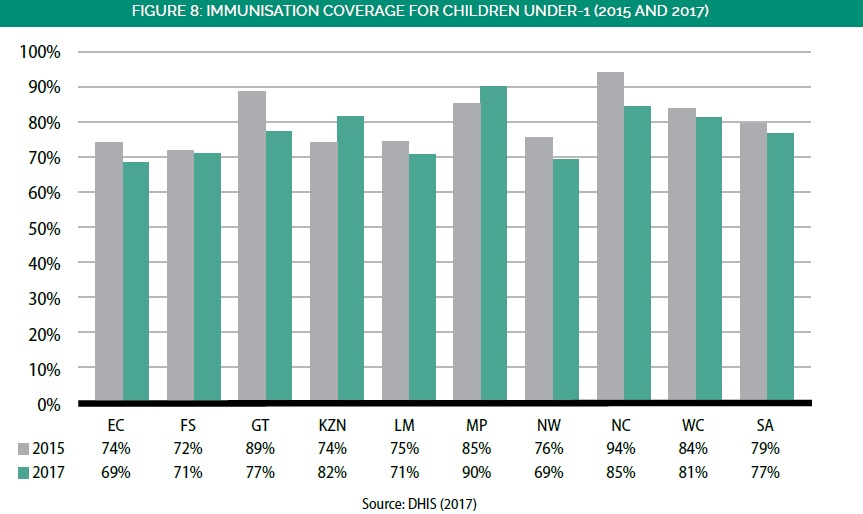
Mortality rates
According to the report, “The ultimate markers of survival and the performance of the health system are child mortality rates. It is encouraging to see the continued decline of infant and under-5 mortality rates. However, the neonatal mortality rate has remained unchanged in recent years.”
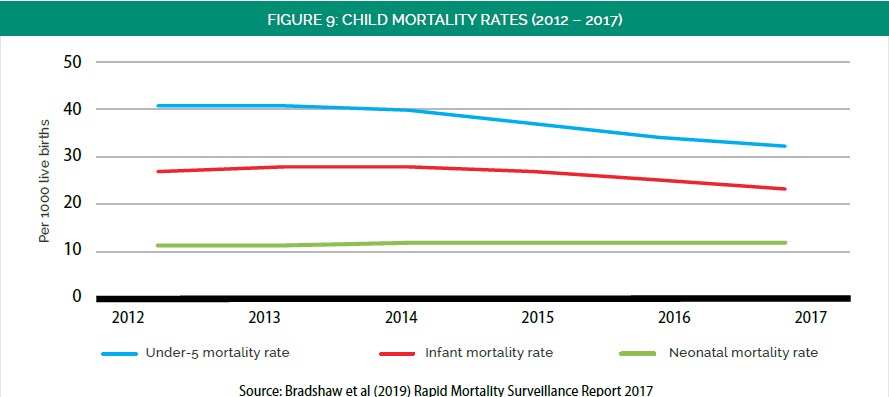
Nutritional support
South Africa has high levels of child malnutrition, despite its status as a middle-income country with a relatively high per capita income compared to other countries in the region. However, per capita income is an average and does not reflect the very high rates of inequality and poverty in the country.
The report states, “Stunting occurs when a child is not growing optimally compared to the expected average growth rate and is the most common form of malnutrition in South Africa.”
Another cause for concern is the prevalence of overweight and obesity among children is on the rise in South Africa.
“An estimated 13% of South Africa’s children aged under five years are classified as overweight. This has mainly been attributed to increased consumption of processed foods high in salt, sugar, and fats, which young children are exposed to through household diets. Statistics from the 2016 South Africa Demographic and Health Survey (SADHS) show that 35% of children aged 6-23 months consumed sugary foods and 44% consumed salty snacks. High levels of inactivity (sedentary lifestyles) also contribute to overweight and obesity. While good nutrition is necessary for basic survival and healthy living for both children and adults, studies have consistently shown that investments in early childhood nutrition yield significant gains in childhood and adulthood.”
However, the nutritional status of a child is highly dependant on the nutritional status of the mother.
Pregnant women who have poor nutritional intake are at greater risk for frequent infections a child that is underweight at birth.
“In South Africa 15% of children are born underweight.”
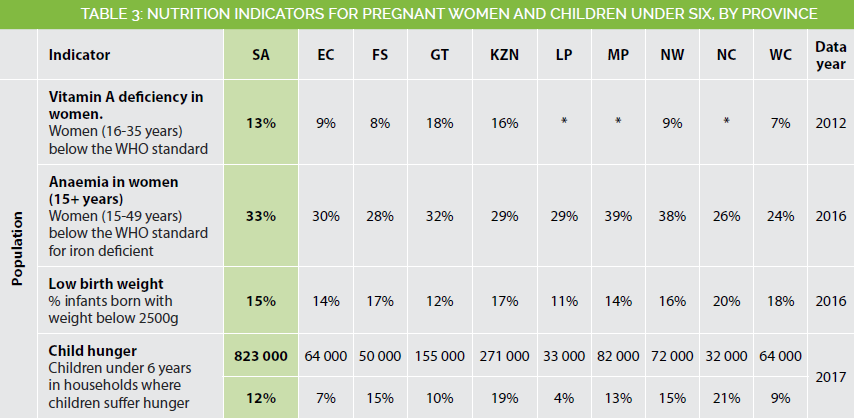
Support for primary caregivers
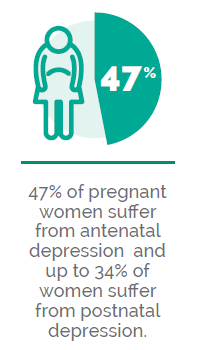
According to the report, “Depression not only limits a woman’s capacity to offer nurturing care to her child but also has adverse outcomes for maternal-infant attachment and bonding, early infant feeding practices, maternal health-seeking behaviour, infant brain development, and the mental health of the child later on in life. Although South Africa has high rates of parental absence, most children under six years do live with their biological mothers. This suggests that investing in educating pregnant women on positive parenting and providing them with psychosocial support throughout pregnancy and the postnatal period will continue to directly benefit the majority of children for the early years of their lives.”
The majority of women in South Africa visit a public health facility for postnatal care six days after the birth of their child. These postnatal care visits give new mothers the critical opportunity for support. The visits also educate mothers on the importance of breastfeeding and also hook them up to community support services.
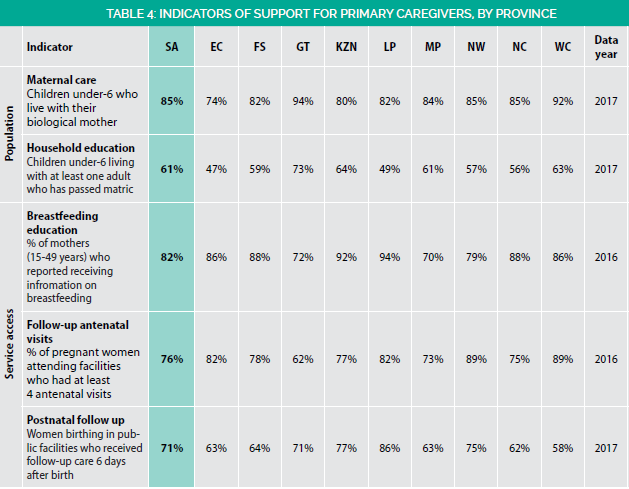
Social services and income support
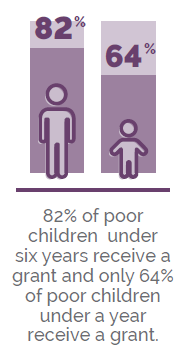
Social grants in South Africa play a major role in alleviating poverty. Under the new government, social assistance programmes have been rolled out to 17.5 million people in 2015, compared to just 2.7 million in 1994.
Access to social grants for young children is lagging behind the targeted uptake levels. The Medium Term Strategic Framework 2014-2019 set a target that grants should reach at least 95% of eligible
people by 2019. In 2017, this target had not been reached: 82% of poor children under six years received a grant and only 64% of poor children.
Educating our young
The South African National Integrated ECD Policy (2015) promotes a broad range of programmes and interventions to support parenting and to enable the delivery of group-based early learning models in a
variety of contexts. These are delivered through a combination of government and non-government providers, with substantial variability in design and quality.
The report on ECD however stresses that home influence is critical in a child’s educational development.
“The influence of children’s home environment and parenting practices on early development is well established. Interactions between parent and child in the first few years of life are especially important for early language, cognitive, and socio-emotional development.”
A recent South African study has found that many caregivers never engage in key activities likely to improve early learning outcomes, such as reading, telling stories, or playing with their children. The study also found that low income families have very little time available for these activities, and possess few resources such as children’s books or toys.
The report states, “While the first two years of life represent an important window of opportunity for brain development, there is very little in place to support early learning for children under two years. Just over one fifth (21%) of children aged birth to two years are enrolled in a group programme for early learning, such as a crèche or playgroup. Another 9% are reported to be in the care of a day mother, childminder, or gogo. The remaining 70% are likely being cared for at home by their mothers or other family members.”
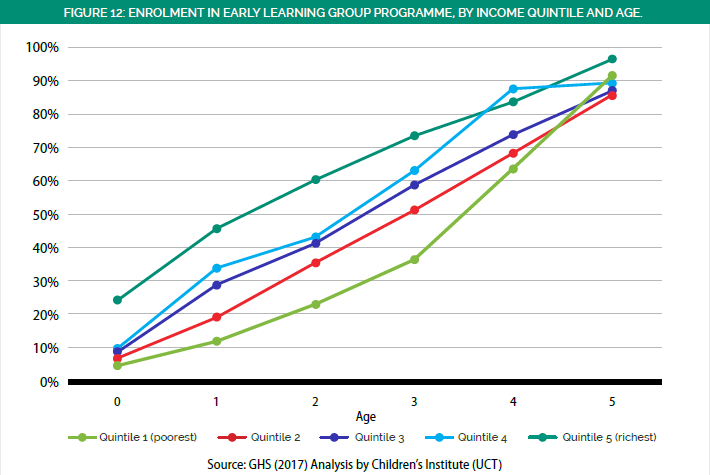
At the release of the ECD report, Dr Kefiloe Masiteng Deputy Secretary of Planning National Planning Commission said, “The National Development Plan 2030 was adopted in 2012. After eight years we have
made some progress on both the policy front and on child development outcomes. For example, the National Integrated Early Childhood Development Policy was adopted in 2015, while maternal and
child mortality rates have continued on a downward trend. Many of the elements of the Essential Package of early childhood development are in place.”
Matsiteng further says that South Africa is a good trajectory when it comes to ECD and added for the country to achieve its goals by 2030 it will take a collaborated effort from all to get to our objectives regarding our children.


